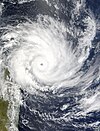
Back بوابة:طقس Arabic دەروازە:کەش و ھەوا CKB Portál:Meteorologie Czech Portal:Wetter und Klima German Portail:Météorologie French Portale:Meteorologia Italian Portal:気象と気候 Japanese 포털:날씨 Korean Portāls:Meteoroloģija Latvian/Lettish Portal:Pogoda Polish
The weather portal
Weather is the state of the atmosphere, describing for example the degree to which it is hot or cold, wet or dry, calm or stormy, clear or cloudy. On Earth, most weather phenomena occur in the lowest layer of the planet's atmosphere, the troposphere, just below the stratosphere. Weather refers to day-to-day temperature, precipitation, and other atmospheric conditions, whereas climate is the term for the averaging of atmospheric conditions over longer periods of time. When used without qualification, "weather" is generally understood to mean the weather of Earth.
Weather is driven by air pressure, temperature, and moisture differences between one place and another. These differences can occur due to the Sun's angle at any particular spot, which varies with latitude. The strong temperature contrast between polar and tropical air gives rise to the largest scale atmospheric circulations: the Hadley cell, the Ferrel cell, the polar cell, and the jet stream. Weather systems in the middle latitudes, such as extratropical cyclones, are caused by instabilities of the jet streamflow. Because Earth's axis is tilted relative to its orbital plane (called the ecliptic), sunlight is incident at different angles at different times of the year. On Earth's surface, temperatures usually range ±40 °C (−40 °F to 104 °F) annually. Over thousands of years, changes in Earth's orbit can affect the amount and distribution of solar energy received by Earth, thus influencing long-term climate and global climate change.
Surface temperature differences in turn cause pressure differences. Higher altitudes are cooler than lower altitudes, as most atmospheric heating is due to contact with the Earth's surface while radiative losses to space are mostly constant. Weather forecasting is the application of science and technology to predict the state of the atmosphere for a future time and a given location. Earth's weather system is a chaotic system; as a result, small changes to one part of the system can grow to have large effects on the system as a whole. Human attempts to control the weather have occurred throughout history, and there is evidence that human activities such as agriculture and industry have modified weather patterns.
Studying how the weather works on other planets has been helpful in understanding how weather works on Earth. A famous landmark in the Solar System, Jupiter's Great Red Spot, is an anticyclonic storm known to have existed for at least 300 years. However, the weather is not limited to planetary bodies. A star's corona is constantly being lost to space, creating what is essentially a very thin atmosphere throughout the Solar System. The movement of mass ejected from the Sun is known as the solar wind. (Full article...)
Selected article
The 2008 Super Tuesday tornado outbreak was a deadly tornado outbreak which affected the Southern United States and the lower Ohio Valley on February 5–6, 2008. In total, 87 tornadoes were confirmed in the outbreak's 15 hour span. Several destructive tornadoes struck heavily populated areas, most notably in the Memphis metropolitan area, in Jackson, Tennessee, and the northeastern end of the Nashville metropolitan area. Fifty-seven people were killed in the outbreak by tornadoes across four states and 18 counties, with hundreds injured and property damage totaling more than $500 million (USD).
The outbreak was the deadliest in the U.S. since the May 31, 1985 outbreak that killed 76 across Ohio and Pennsylvania (and also killed 12 in Ontario, Canada). It also was the deadliest tornado outbreak in both Tennessee and Kentucky since the 1974 Super Outbreak. In addition to the tornadoes, the same system produced significant straight-line wind damage, hail as large as softballs, or 4.50 inches (11 cm) in diameter, major flooding, significant freezing rain, and heavy snow across many areas of eastern North America.

Recently selected articles: Cyclone Elita, Winter service vehicle, More...
Did you know (auto-generated) -

- ... that Japanese actor Kouhei Higuchi prepared for his role on the television drama adaptation of My Personal Weatherman by learning from a weather forecaster?
- ... that extreme event attribution estimates how much climate change causes weather events, such as the 2021 Western North America heat wave?
- ... that the weather forecast for HD 189733 b is "Westerly winds at 2000 m/s, with molten glass showers"?
- ... that after Irish post office clerk Maureen Flavin Sweeney reported worsening weather conditions, Dwight D. Eisenhower agreed to postpone D-Day by 24 hours?
- ... that Eric Berger wrote about weather for the Houston Chronicle even before he became a certified meteorologist?
- ... that in the 1980s, "Sherman Bonner, The Human Thermometer" presented the weather on an Arkansas TV station?
Selected image

Mammatus (also known as mamma or mammatocumulus, meaning "breast-cloud") is a meteorological term applied to a cellular pattern of pouches hanging underneath the base of a cloud. The name "mammatus" is derived from the Latin mamma (breast), due to the resemblance between the shape of these clouds and human female breasts. Mammatus are most often found on the anvil cloud that extends from a cumulonimbus, and therefore are commonly associated with severe weather.
Recently selected pictures: Von Kármán vortex street, Crepuscular rays, Cumulonimbus cloud, More...
More did you know...
...that the Flying river is the name given to the transport of water vapor from the Amazon rainforest to southern Brazil?
...that hurricane shutters are required for all homes in Florida unless impact-resistant glass is used?
...that the Joint Institute for Marine and Atmospheric Research is a combined weather and ocean research institute with the cooperation of the Office of Oceanic and Atmospheric Research and the University of Hawaiʻi?
...that the SS Central America was sunk by a hurricane while carrying more than 30,000 pounds (13,600 kg) of gold, contributing to the Panic of 1857?
...that a hurricane force wind warning is issued by the United States National Weather Service for storms that are not tropical cyclones but are expected to produce hurricane-force winds (65 knots (75 mph; 120 km/h) or higher)?
...that the Automated Tropical Cyclone Forecasting System is a software package for tropical cyclone forecasting developed in 1988 that is still used today by meteorologists in various branches of the US Government?
Recent and ongoing weather
- Wikinews weather portal
- March 26, 2021: Tropical moisture ceases to cause severe floods in South East Australia
- February 19, 2021: Winter storms hammer Texas, fatalities reported
- December 28, 2021: Typhoon Phanfone strikes Philippines
- February 1, 2022: Deadly floods in Brazil after heavy rainfall
- April 15, 2022: South African floods kill at least 300 people
- Weather of 2024
- 2024 Atlantic hurricane season
- 2020–21 North American winter
- 2024 Pacific typhoon season
- Tornadoes of 2024
This week in weather history...
May 15: Start of the East Pacific hurricane season and end of the Mauritius and Seychelles cyclone season
1966: The Nimbus 2 weather satellite was launched. It collected information about atmospheric temperature and cloud cover until early 1969.
May 16
1986: Severe flooding from an ice jam completely destroyed the town of Winisk, Ontario, which was subsequently abandoned. Two people were killed.
May 17
2001: A Yakovlev Yak-40 aircraft crashed while flying through a thunderstorm near Sari, Iran, killing 30 people, including several members of the Islamic Consultative Assembly and other government officials.
May 18
1902: A tornado killed 114 in Goliad, Texas.
May 19
2018: Cyclone Sagar struck northwestern Somalia, killing 56 people in three countries. It was the strongest tropical cyclone on record to strike Somalia.
May 20
1916: A tornado struck the town of Codell, Kansas. Incredibly, the same town would be hit by two more tornadoes on May 20, 1917 and May 20, 1918.
May 21
1976: Typhoon Pamela passed over the island of Guam, damaging or destroying 80% of the island's buildings but only killing one person.
Selected biography
Clement Lindley Wragge (18 September 1852 – 10 December 1922) was a meteorologist born in Stourbridge, Worcestershire, England, but moved to Oakamoor, Staffordshire as a child. He set up the Wragge Museum in Stafford following a trip around the world. He was a Fellow of the Royal Geographical Society and in 1879 was elected Fellow of the Royal Meteorological Society in London. To the end of his life, he was interested in Theosophy and spiritualism. During his tour of India he met with Mirza Ghulam Ahmad of Qadian, the founder of the Ahmadiyya movement in Islam who had claimed to be the Mahdi, the messianic redeemer awaited by Muslims. Sir Arthur Conan Doyle sought him out in New Zealand to ask for his views on spiritualism before writing The Wanderings of a Spiritualist in 1921. After training in law, Wragge became a meteorologist, his accomplishments in the field including winning the Scottish Meteorological Society's Gold Medal and years later starting the trend of using people's names for cyclones. He travelled widely, giving lectures in London and India, and in his later years was an authority on Australia, India and the Pacific Islands. (Full article...)
Previously selected biographies: Robert Case, Wladimir Köppen, More...
Related portals
Quality content
Other candidates:
- Featured Article Review: 2005 Atlantic hurricane season (Discussion)
- Featured List Removal Candidate: List of storms in the 2005 Atlantic hurricane season (Discussion)
Subcategories
WikiProjects
The scope of WikiProject Weather is to have a single location for all weather-related articles on Wikipedia.
WikiProject Meteorology is a collaborative effort by dozens of Wikipedians to improve the quality of meteorology- and weather-related articles. If you would like to help, visit the project talk page, and see what needs doing.
WikiProject Severe weather is a similar project specific to articles about severe weather. Their talk page is located here.
WikiProject Tropical cyclones is a daughter project of WikiProject meteorology. The dozens of semi-active members and several full-time members focus on improving Wikipedia's coverage of tropical cyclones.
WikiProject Non-tropical storms is a collaborative project to improve articles related to winter storms, wind storms, and extratropical cyclones.
Wikipedia is a fully collaborative effort by volunteers. So if you see something you think you can improve, be bold and get to editing! We appreciate any help you can provide!
Associated Wikimedia
The following Wikimedia Foundation sister projects provide more on this subject:
-
Commons
Free media repository -
Wikibooks
Free textbooks and manuals -
Wikidata
Free knowledge base -
Wikinews
Free-content news -
Wikiquote
Collection of quotations -
Wikisource
Free-content library -
Wikiversity
Free learning tools -
Wiktionary
Dictionary and thesaurus
Other Portals
What you can do
© MMXXIII Rich X Search. We shall prevail. All rights reserved. Rich X Search
































